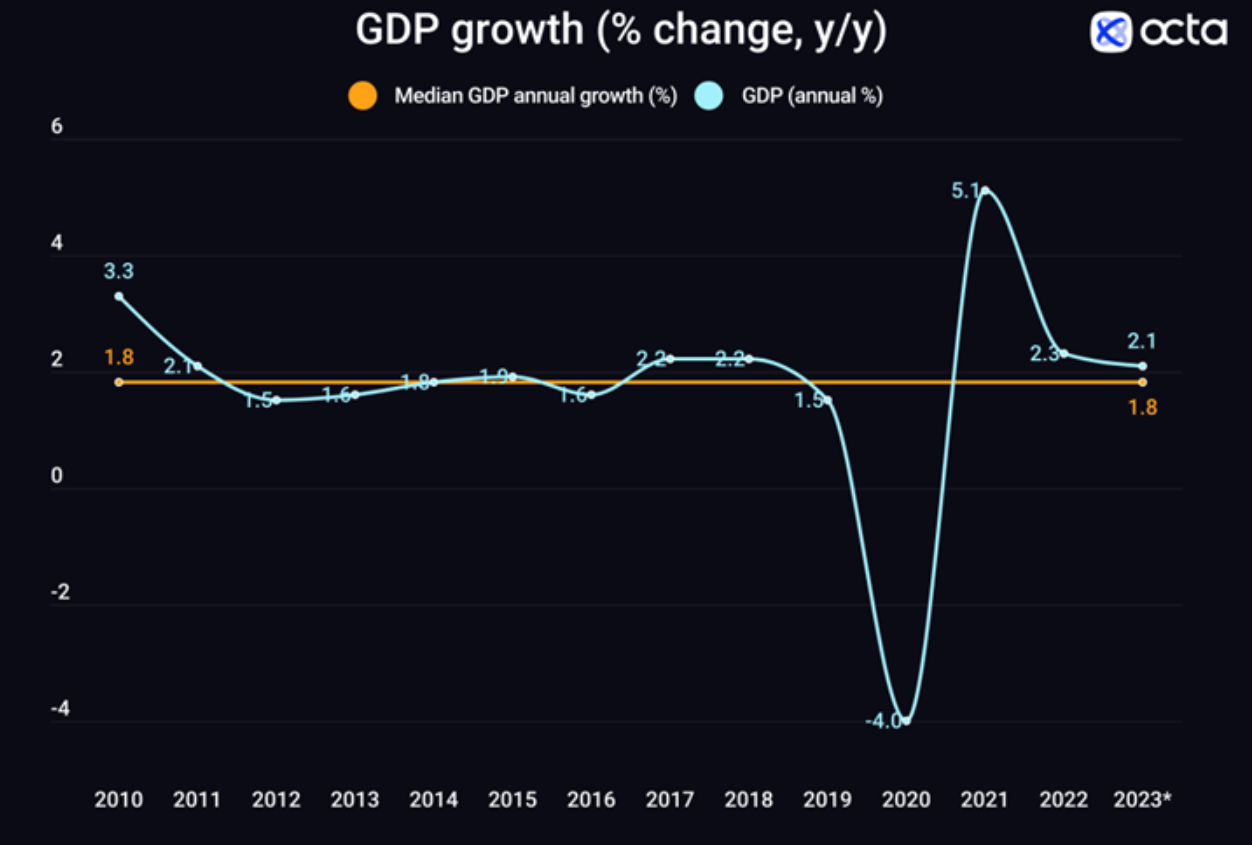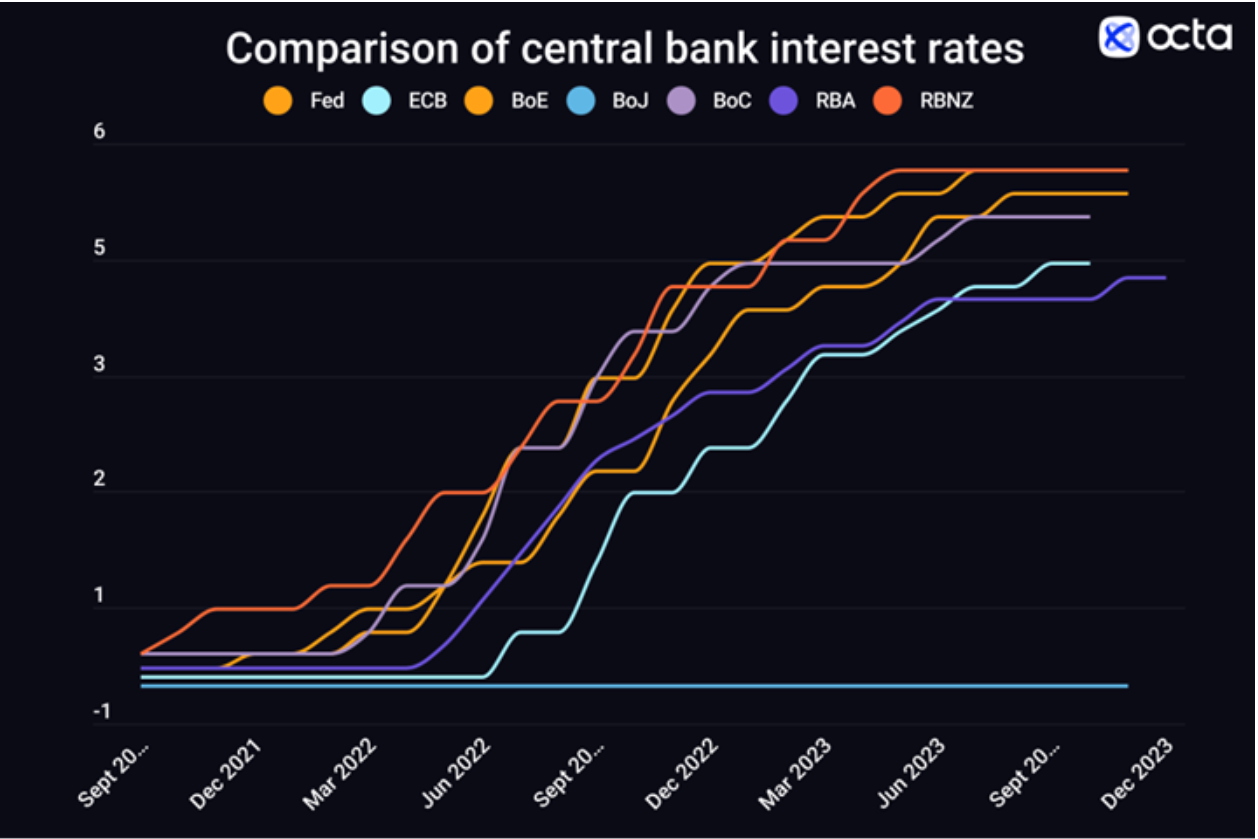In 2023, high-interest rates caused global equities to fall, depreciating emerging market currencies and slowing global growth. Military conflicts reached the highest level since the Cold War, affecting capital markets. In this article, Octa analysts take readers back to the events of 2023 and explain the underlying patterns along the way.
In 2023, the economic situation was primarily influenced by inflation, remaining above the targets set by policymakers. Given the harmful nature of elevated inflation, central banks pursued aggressive monetary policies.
This led to a substantial decline in interest rate-sensitive government bonds and equities of companies in cyclical sectors of the economy. The only exception in 2023 was oil and gas stocks, which showed a positive trend on the back of steadily high energy prices.
This uneven decline paints the 2023 financial markets in gloomy colours. However, the overall situation is not so bad if we look more globally.
Not a recession, but a return to normality
In 2023, the global economy is still reeling from the effects of the unprecedented economic stimulus undertaken during COVID-19—it was one of the biggest jumps in real GDP and inflation in history. Not surprisingly, after such a massive boom, the economy began to cool down while showing a decline in real GDP growth.
’A 2–4% drop in real GDP growth amid rising inflation is associated with the economy slowdown. However, if we start with nominal growth rates over the last decade, the decline in the previous two years has only returned nominal growth to the norm,’ said Kar Yong Ang, Octa’s financial market analyst.

’The slowdown to normal growth rates inspires confidence that a recession will be avoided. However, the ongoing decline is likely to persist for at least the next six months, and it remains to be seen whether a soft or hard landing lies ahead, but it is certainly close at hand,’ added Kar Yong Ang.
U.S. macroeconomic performance as a trigger
High inflation and unemployment rates, the usual precursors of recession, are nowhere to be seen, which is not typical for an economic slowdown. The inflation marker is more or less clear—it has been on a downward trend for over a year and a half. The employment rate is a bit more complicated.
Changes in labour costs are mainly determined by cyclical sectors of the economy, which, as we said earlier, have experienced a severe decline. When a company’s cash flow remains positive, the employment rate remains high. Reducing revenue for cyclical companies leads to cost optimisation—like reducing aggregate weekly working hours and the number of employees. A decline in consumer wage income similarly leads to reduced consumer activity.
It turns out that employment is sensitive to changes in corporate revenues: the less companies earn, the more likely they are to reduce the number of employees and their working hours. Hence, there is an intense focus on employment, hours worked, and manufacturing survey metrics—all aimed at deciphering clues about the outlook for the economy, profits, and risk assets.
In the second half of 2023, the number of jobs created each month has been declining. This trend is consistent with the continued slowdown in GDP. The weakening labour market is beginning to manifest itself in rising delinquencies, lower demand for credit and more bankruptcies. These trends usually lead to a recession, so financial markets are pinning their hopes on the Fed to implement stimulative monetary policy before that happens.
It all comes down to interest rates
At the end of the third quarter, many investors expected that global interest rates had peaked and could fall in the coming quarters. However, no miracle happened: central banks chose a wait-and-see tactic in the second half of 2023, making infrequent adjustments to their monetary policies.

Many major economies remained at the end of the rate hike cycle and the beginning of a new business cycle. The U.S. economy proved less sensitive to interest rates and was able to withstand monetary tightening: we saw moderate growth in business activity with few exceptions. Soft Chinese growth was possible due to the strategy of rate cuts and expansion of economic stimulus against the backdrop of the not-very-successful China reopening at the beginning of the year. Europe, in turn, lost momentum on the back of a manufacturing slowdown and rising oil prices.
Gold rose to an all-time high in 2023
After two unremarkable years, gold rose 171.88 %/oz t or 9.42% since the start of the year, hitting an all-time high in August 2020 by closing at 2,071.95 %/oz t on 1 December.
‘Investors’ expectations have played a key role in driving gold prices higher in late 2023 as investors become uninterested in falling bond and equity yields amid the continued sharp slowdown in U.S. inflation and in response to the Federal Reserve’s recent decisions to refrain from raising interest rates,’ said Kar Yong Ang, Octa’s financial market analyst. Lower expected returns on cash are forcing investors to look for better alternatives. Also, he added that when interest rates fall due to an economic downturn or recession, equities may struggle to provide positive returns.
Gold ultimately serves as a hedge against economic risks and fears, offering a unique diversification quality to investors’ portfolios as it is not correlated with bonds and equities. Judging by the momentum, the price momentum at the end of 2023 is an emerging trend for 2024.
Impact of geopolitical tensions on different assets
According to the Uppsala Conflict Data Programme, 2023 has become the most conflict-prone year since the Cold War. The list includes not only the armed conflict in Ukraine and Gaza but also the confrontation between Armenia and Azerbaijan in Nagorno-Karabakh, the actions of Serbian security forces in Kosovo, the fighting in Eastern Congo, the conflict in Sudan that started back in April, and the fragile truce in Tigray, which Ethiopia seems likely to break at any moment.
The situation in Syria and Yemen during this period has hardly been calm either, with gangs and cartels posing a constant threat to governments in South and North America, most notably in Haiti and Mexico. And all this is not counting the war that could break out in East Asia if China invades the island of Taiwan. We see all the conflicts cascading.
Such large-scale fighting always leads to multipolarity and disorder, which creates supply shock. Conflicts scare investors away from intangible asset classes such as local fixed-income instruments (local bonds) in favour of more tangible ones— energy (oil, uranium, gas), metals (for example, lithium), fertile land per se and technology (chips, AI, cybersecurity, green energy, biotech, and others).
The dynamics of currency values also clearly demonstrated the impact of conflicts. Thus, in countries where these conflicts occur, currencies fell in value: USDRUB +32.41% YtD, USDTRY +54.86% YtD. In countries observing nearshoring effects (capital and technology spillover), the currency strengthened (for example, USDMXN –10.94% YtD). Some local currencies were destroyed by inflation and central bank quantitative teasing (USDJPY +12.38% YtD).
2023 was not a calm year—it was filled with challenges and complex geopolitical stories that kept much of the world’s population on edge. World Central Banks tried to mitigate the adverse effects of the events of 2022 and 2023 by fine-tuning their economies. We continue to see a tense world at the juncture of the years, and there was no resolution this year.
Octa is an international broker that has been providing online trading services worldwide since 2011. It offers commission-free access to financial markets and various services already utilised by clients from 180 countries with more than 42 million trading accounts. Free educational webinars, articles, and analytical tools they provide help clients reach their investment goals.
The company is involved in a comprehensive network of charitable and humanitarian initiatives, including the improvement of educational infrastructure and short-notice relief projects supporting local communities.
Octa has also won over 60 awards since its foundation, including the ‘Best Educational Broker 2023’ award from Global Forex Awards and the ‘Best Global Broker Asia 2022’ award from International Business Magazine.























